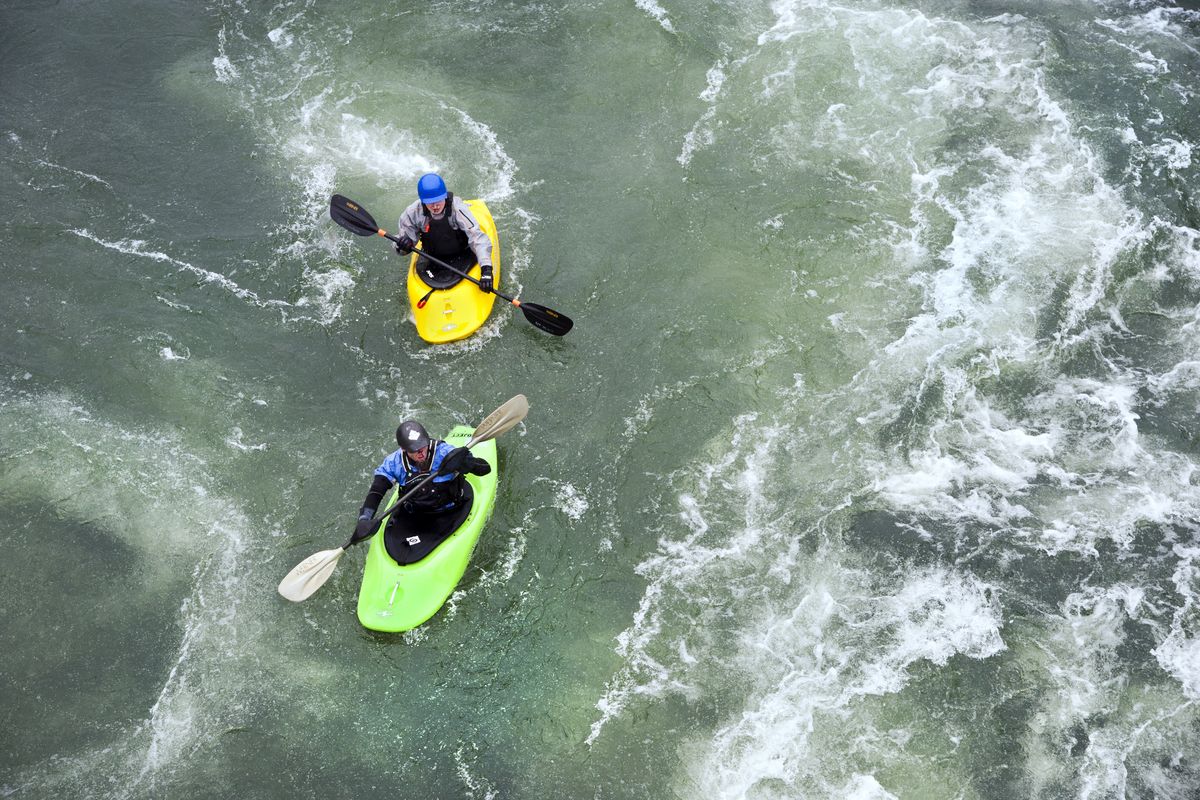In the flow: Paddlers get it while it lasts

Whether it’s on the Clark Fork, the Spokane or the Lochsa, the Inland Northwest boasts some incredible opportunities for paddling on the river.
And given such a brilliant, warm spring, the rapids are currently primed for the taking.
“Right now, the water is right at my favorite level to take people down the Spokane for the first time,” said Jon Wilmot, owner of FLOW Adventures in Spokane.
Wilmot typically opens his whitewater season on May 1, however this spring he’s moved that time frame up an entire month. But while the early season is a blessing for those itching to dust off the kayak, the “good white water” might not be around for long.
The Spokane River, for instance, is currently flowing at 16,000-17,000 cubic feet per second (CFS), but often runs over 30,000 CFS in the spring. The river is typically running under 1,000 CFS by late summer, but this year, that could be the case for the entire summer.
“People will notice,” said Guy Gregory, a senior hydrogeologist for the Washington State Department of Ecology. “We can expect to see an earlier lowering of [the Spokane] River and river flows that are typical of late summer.”
Take Devil’s Toenail, for example. This popular Class III rapid on the Spokane has been navigable the first week of July the past few years, but Wilmot doubts that will be the case this year.
“We only have a certain window before the water drops and the Toenail becomes really tough to get through safely,” Wilmot said. “If we have a wet spring and we get some snow up high, it could stretch that out.”
The early season isn’t as much of a concern for Eastern Washington University’s EPIC Adventures, which offers paddling trips and instruction to students, faculty and staff. EPIC does the lion’s share of its rafting while school is in session – that is, in the spring.
EPIC – which is funded by student fees and offers non-credited classes – typically uses the Spokane, the Clark Fork and the Wenatchee rivers for its trips and trains EWU students to become whitewater rafting guides, according to John Fair, assistant director of outdoor programs.
“A lot of our students end up working for EPIC,” said Fair. “Some of them go on and make full careers out of it.”
Of course, private lessons and clinics are available for those hoping to improve their kayaking and/or paddling skills. But keep in mind, this “pastime” requires a certain level of commitment.
For a beginning kayaker, “it takes about 12 hours of instruction time,” said Wilmot. “Just to get somebody comfortable in the boat on flat water takes about six hours.”
Once you do get comfortable in the boat, you’ll probably want to find other people who are too.
The Spokane Canoe and Kayak Club has been around since the 1970s and is “dedicated to promoting safe and fun paddling of all types.” More experienced paddlers will benefit from the camaraderie, and beginners will benefit from having more experienced paddlers to help them fine-tune their skills.
“If somebody is willing to put forth the effort, we’re going to put forth that time and energy to help them get better,” former SCKC president Celene Olgeirsson said. “But it’s a commitment.”
One of the focuses of the club is to promote safety.
“It’s important to have the right equipment, first and foremost,” said Olgeirsson, who admitted that beginners will often buy new equipment without proper consultation. “Always dress for the water temperature … if you fall out of your boat, you could be in the water for a while.”
For various stretches throughout the season, the SCKC has whitewater paddling on Wednesday evenings and flat water paddling on Thursday evenings. Also, the club participates in or sponsors several clinics throughout the year.
With an abundance of rivers in the Inland Northwest to raft, kayak and canoe, the Spokane River is sometimes underestimated. It has an upper section that is great for beginners and a lower section that sets up well for more experienced paddlers, Olgeirsson said.
And while you may have driven along the river thousands of times, being on the water is a much more scenic experience.
“The Spokane is a great place to get started,” Wilmot said. “I’ve taken a lot of people down who have lived here their whole lives and have never been on the river.
“It’s a gem.”